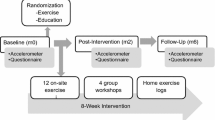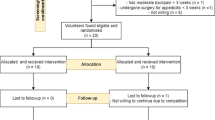Abstract
Background
Despite the proven benefits of physical activity to treat and prevent metabolic diseases, such as diabetes (T2D) and metabolic syndrome (MetS), most individuals with metabolic disease do not meet physical activity (PA) recommendations. PA is a complex behavior requiring substantial motivational and cognitive resources. The purpose of this study was to examine social cognitive and neuropsychological determinants of PA behavior in older adults with T2D and MetS. The hypothesized model theorized that baseline self-regulatory strategy use and cognitive function would indirectly influence PA through self-efficacy.
Methods
Older adults with T2D or MetS (M age = 61.8 ± 6.4) completed either an 8-week physical activity intervention (n = 58) or an online metabolic health education course (n = 58) and a follow-up at 6 months. Measures included cognitive function, self-efficacy, self-regulatory strategy use, and PA.
Results
The data partially supported the hypothesized model (χ2 = 158.535(131), p > .05, comparative fit index = .96, root mean square error of approximation = .04, standardized root mean square residual = .06) with self-regulatory strategy use directly predicting self-efficacy (β = .33, p < .05), which in turn predicted PA (β = .21, p < .05). Performance on various cognitive function tasks predicted PA directly and indirectly via self-efficacy. Baseline physical activity (β = .62, p < .01) and intervention group assignment via self-efficacy (β = −.20, p < .05) predicted follow-up PA. The model accounted for 54.4 % of the variance in PA at month 6.
Conclusions
Findings partially support the hypothesized model and indicate that select cognitive functions (i.e., working memory, inhibition, attention, and task-switching) predicted PA behavior 6 months later. Future research warrants the development of interventions targeting cognitive function, self-regulatory skill development, and self-efficacy enhancement.
Trial Registration Number
The trial was registered with the clinical trial number NCT01790724.


Similar content being viewed by others
References
Shaw JE, Sicree RA, Zimmet PZ. Global estimates of the prevalence of diabetes for 2010 and 2030. Diabetes Res Clin Pract. 2010; 87(1): 4–14.
Grundy SM. Metabolic syndrome pandemic. Arterioscler Thromb Vasc Biol. 2008;28:629–636.
CDC. National diabetes fact sheet: general information and national estimates on diabetes in the United States, 2012. Available from: http://www.cdc.gov/diabetes/library/factsheets.html. 2014. September 23, 2015.
Aguilar M, Bhuket T, Torres S, Liu B, Wong RJ. Prevalence of the metabolic syndrome in the United States, 2003-2012. JAMA. 2015;313(19):1973–1974.
Hendrickx H, McEwen BS, van der Ouderaa F. Metabolism, mood, and cognition in aging: The importance of lifestyle and dietary intervention. Neurobiol Aging. 2005; 26S: S1-S5.
Kumar A, Haroon E, Darwin C, et al. Gray matter prefrontal changes in type 2 diabetes detected using MRI. JMRI. 2008; 27: 14–19.
Messier C. Impact of impaired glucose tolerance and Type 2 diabetes on cognitive aging. Neurobiol Aging. 2005; 26S: S94–97.
Ryan CM. Diabetes, aging, and cognitive decline. Neurobiol Aging. 2005; 26S: S21–25.
Awad N, Gagnon M, Messier C. The relationship between impaired glucose tolerance, type 2 diabetes, and cognitive function. J Clin Exp Neuropsyc. 2004; 26: 1044–1080.
Gold SM, Dziobek I, Sweat V, et al. Hippocampal damage and memory impairments as possible early brain complications of type 2 diabetes. Diabetologia. 2007; 50: 711–719.
Hassenstab JJ, Sweat V, Bruehl H, Convit A. Metabolic syndrome is associated with learning and recall impairment in middle age. Dement Geriatr Cogn. 2010; 29: 356–362.
Church TS, Blair SN, Cocreham S, et al. Effects of aerobic and resistance training on hemoglobin A1c levels in patients with type 2 diabetes: A randomized controlled trial. JAMA. 2010; 304(20): 2253–2262.
Jeon CY, Looken RP, Hu FB, van Dam RM. Physical activity of moderate intensity and risk of type 2 diabetes: A systematic review. Diabetes Care. 2007; 30: 744–752.
Grundy SM, Cleeman JI, Daniels SR, et al. Diagnosis and management of the metabolic syndrome: An American Heart Association/National Heart, Lung, and Blood Institute scientific statement. Circulation. 2005; 112: 2735–2752.
Duncan GE, Perri MG, Theriaque DW, Hutson AD, Eckel RH, Stacpoole PW. Exercise training, without weight loss, increases insulin sensitivity and postherparin plasma lipase activity in previously sedentary adults. Diabetes Care, 2003; 26: 557–562.
Balducci S, Iacobellis G, Parisi L, et al. Exercise training can modify the natural history of diabetic peripheral neuropathy. J Diabetes Complicat. 2006; 20(4): 216–223.
Sigal RJ, Armstrong MJ, Colby P, et al. Physical activity and diabetes. Can J Diabetes. 2013; 37(1): S40-S44.
ACSM/ADA Joint Position Statement. Exercise and type 2 diabetes. MSSE. 2010; 42(12): 2282–2303.
Nwasuruba CK, Khan M, Egede LE. Racial/ethnic differences in multiples self-care behaviors in adults with diabetes. J Gen Intern Med. 2007; 22: 115–120.
McAuley E, Blissmer B. Self-efficacy determinants and consequences of physical activity. Exerc Sport Sci Rev. 2000; 28(2): 85–88.
Kelley WM, Wagner DD, Heatherton TF. In search of a human self-regulation system. Annu Rev Neurosci. 2015; 38: 389–411.
McAuley E, Mullen SP, Szabo AN, et al. Self-regulatory processes and exercise adherence in older adults: Executive function and self-efficacy effects. Am J Prev Med. 2011; 41(3): 284–290.
Bandura A. Social foundations of thought and action: A social cognitive theory. Englewood Cliffs, NJ: Prentice Hall; 1986.
Bandura A. Health promotion by social cognitive means. Health Educ Behav. 2004; 31: 143–164.
de Jager CA, Budge MM, Clarke R. Utility of TICS-M for the assessment of cognitive function in older adults. Int J Geriatr Psych. 2003; 18: 318–324.
Olson EA, McAuley E. Impact of a brief physical activity intervention in older adults with type 2 diabetes. J Behav Med. 2015; 11: 1–13.
Masse L, Fummeler B, Anderson C, et al. Accelerometer data reduction: A comparison of four reduction algorithms on select outcome variables. MSSE. 2005; 37(11): S544-S554.
Copeland JL. Accelerometer assessment of physical activity in active, healthy older adults. J Aging Phys Activ. 2009; 17: 17–30.
Mailey EL, Gothe NP, Wojcicki TR, et al. Influence of allowable interruption period on estimates of accelerometer wear time and sedentary time in older adults. J Aging Phys Activ. 2014; 22(2): 255–260.
Freedson PS, Melanson E, Sirand J. Calibration of the computer science and applications, inc. accelerometer. MSSE.1998; 30: 777–781.
Miyake A, Friedman NP, Emerson MJ, Witzki AH, Howerter A, Wager TD. The unity and diversity of executive functions and their contributions to complex “Frontal Lobe” tasks: A latent variable analysis. Cognitive Psychol. 2000; 41(1): 49–100.
Erickson KI, Colcombe SJ, Wadhwa R, et al. Training-induced plasticity in older adults: Effects of training on hemispheric asymmetry. Neurobiol Aging. 2007; 28(2): 272–83.
Milham MP, Erickson KI, Banich MT, et al. Attentional control in the aging brain: insights from an fMRI study of the stroop task. Brain Cognition. 2002; 49(3): 277–296.
Kirchner WK. Age differences in short-term retention of rapidly changing information. J Exp Psychol. 1958; 55(4): 352–358.
Townsend JT, Ashby FG. Methods of modeling capacity in simple processing systems. In: Castellan J, Restle F, eds. Cognitive theory. Vol. 3. Hillsdale, NJ: Erblaum; 1978: 200–239.
Bherer L, Kramer A, Peterson M, Colcombe S, Erickson K, Becic E. Training effects on dual-task performance: Are there age-related differences in plasticity of attentional control? Psychol Aging. 2005; 20(4): 695.
McAuley E. The role of efficacy cognitions in the prediction of exercise behavior in middle-aged adults. J Behav Med. 1992; 15(1): 65–88.
McAuley E, Lox C, Duncan TE. Long-term maintenance of exercise, self-efficacy, and physiological change in older adults. J Gerontol B Psychol Sci Soc Sci. 1993; 48(4): P218-P224.
McAuley E, Blissmer B, Marquez DX, Jerome GJ, Kramer AF, Katula J. Social relations, physical activity, and well-being in older adults. Prev Med. 2000; 31(5): 608–617.
McAuley E, Hall KS, Motl RW, et al. Trajectory of declines in physical activity in community-dwelling older women: Social cognitive influences. J Gerontol B Psychol Sci Soc Sci. 2009; 64B(5): 543–550.
Umstattd MR, Motl R, Wilcox S, Saunders R, Watford M. Measuring physical activity self-regulation strategies in older adults. J Phys Act Health. 2009; 6: S105-S112.
Múthen LK, Múthen BO. Mplus User’s Guide. Seventh Edition. Los Angeles, CA: Múthen & Múthen; 2012.
Hu L, Bentler PM. Cutoff criteria for fit indices in covariance structure analysis: Conventional criteria versus new alternatives. Struct Equ Modeling. 1999; 6(1): 1–55.
Graham JW, Hofer SM. Mulitple imputation in multivariate research. In: Little TD, Schnabel KU, Baumert J, eds. Modeling longitudinal and multiple-group data: Practical issues, applied approaches, and specific examples. Hillsdale, NJ: Erlbaum; 2000.
Heatherton TF, Wagner DD. Cognitive neuroscience of self-regulation failure. Trends Cogn Sci. 2011; 15(3): 132–139.
Hofmann W, Friese M, Schmeichel BJ, Baddeley AD. Working memory and self-regulation. In: Vohs KD, Baumeister RF, eds. Handbook of Self-Regulation. New York, NY: Guuilford Press; 2011: 206–225.
Kent M, Rivers CT, Wrenn G. Goal-directed resilience in training (GRIT): A biopsychosocial model of self-regulation, executive functions, and personal growth (eudaimonia) in evocative contexts of PSTD, obesity, and chronic pain. Behav Sci. 2015; 5: 264–304.
Tops M, Boksem MAS, Quirin M, Ijzerman H, Koole SL. Internationally directed cognition and mindfulness: An integrative perspective derived from predictive and reactive control systems theory. FPSYG. 2014; 5: 1–21.
Hall PA, Fong GT. Temporal self-regulation theory: a neurobiologically informed model for physical activity behavior. Frontiers Hum Neurosci. 2015; 9: 117.
Miyake A, Friedman NP. The nature and organization of individual differences in executive functions: Four general conclusions. Curr Dir Psychol Sci. 2012; 21(1): 8–14.
Buckley J, Cohen JD, Kramer AF, McAuley E, Mullen SP. Cognitive control in the self-regulation of physical activity and sedentary behavior. Frontiers Hum Neurosci. 2014; 29: 747.
Rebar AL, Loftus AM, Hagger MS. Cognitive control and the non-conscious regulation of health behavior. Frontiers Hum Neurosci. 2015; 9: 122.
Eggermont LHP, Milberg WP, Lipsitz LA, Scherder EJA, Leveille SG. Physical activity and executive function in aging: The MOBILIZE Boston Study. J Am Geriatr Soc. 2009:57(10):1750–1756.
Baniqued P, Allen CM, Kranz MB, Johnson K, Sipolins A, Dickens C, Ward N, Geyer A, Kramer AF. Working memory, reasoning, and task switching training: Transfer effects, limitations, and great expectations? PLOS One. 2015:10(11):e0142169.
Fregni F, Boggio PS, Nitsche M, Bermpohl F, Antal A, Feredoes E, et al. Anodal transcranial direct current stimulation of prefrontal cortex enhances working memory. Exp Brain Res. 2005:166:23–30.
Zeidan F, Johnson SK, Diamond BJ, David Z, Goolkasian P. Mindfulness meditation improves cognition: Evidence of brief mental training. Conscious Cogn. 2010:19(2):597–605.
Acknowledgments
Research was funded by the National Institute on Aging: F31AG042232, R01AG0200118, 5T32AG023480-10; the Shahid Khan and Ann Carlson Khan Endowed Professorship; and the National Institute for Agriculture—Illinois Transdisciplinary Obesity Prevention Program grant (2011-67001-30101) to the Division of Nutritional Sciences at the University of Illinois.
Author information
Authors and Affiliations
Corresponding author
Ethics declarations
Authors’ Statement of Conflict of Interest and Adherence to Ethical Standards
Authors Olson, Mullen, Raine, Kramer, Hillman, and McAuley declare that they have no conflict of interest. All procedures, including the informed consent process, were conducted in accordance with the ethical standards of the responsible committee on human experimentation (institutional and national) and with the Helsinki Declaration of 1975, as revised in 2000.
Additional information
Note: First author’s current affiliation is McKinsey & Company, Denver, CO. All research was conducted at the University of Illinois.
About this article
Cite this article
Olson, E.A., Mullen, S.P., Raine, L.B. et al. Integrated Social- and Neurocognitive Model of Physical Activity Behavior in Older Adults with Metabolic Disease. ann. behav. med. 51, 272–281 (2017). https://doi.org/10.1007/s12160-016-9850-4
Published:
Issue Date:
DOI: https://doi.org/10.1007/s12160-016-9850-4




